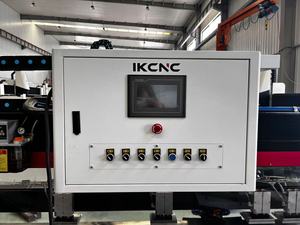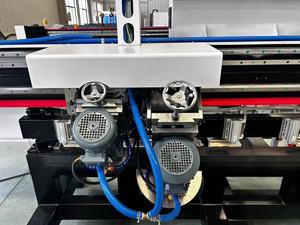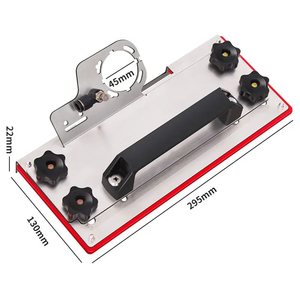
All categories
Featured selections
Trade Assurance
Buyer Central
Help Center
Get the app
Become a supplier

(1709 products available)


























The chamfer device appears in several types, each designed for specific applications and materials.
Manual chamfering tools
They include handheld files, bevel knives, or edge trimmers, which are popular for small, simple chamfering tasks on soft materials. It is perfect for doing on metal, wood, and plastics. Normally, manual devices are portable and inexpensive, but they take longer to chamfer. These tools remain ideal for low-volume production or workshop settings where fine control gets required.
Electric chamfering tools
Electric chamfering tools use only power to make chamfers quickly and consistently. Common in woodworking and metalworking factories, these are tools to manage large volumes. While the tool removes chamfer angles better, it requires users to give better attention to detail while doing it. Electric devices are suitable where there should be a high yield and repeatability.
CNC chamfer milling cutters
These are expensive tools that attach to computer-controlled machines. These cutters create very accurate and complicated chamfer profiles. These cutting tool inserts work well with production runs of designs requiring many copies. The depth of the chamfer and its angle in this machinery are controlled by the computer. CNC chamfer cutters are widely used in the automotive, aerospace, and other businesses.
Hydraulic chamfering tools
A chamfer device with hydraulic or pneumatic force is intended for tough, high-stakes industrial jobs. They work great on metal and can deliver large forces. In situations where power is required, such as for thick metal plates, hydraulic tools excel. These are suitable for extreme circumstances where standard tools would fail due to wear or power.
Carbide chamfer milling cutters
The carbide chamfer milling cutter has unbelievably hard carbide tips set at different angles to the workpiece. This cutter makes long-lasting, wear-resistant, and heat-resistant chamfers imaginable. It is effective at machining hard materials like steel and titanium. Carbide tools get often employed in areas that need precision, such as defense or high-tech manufacturing.
The main function of chamfering tools is to make angular cuts at the edges of workpiece materials. This edge preparation improves manufactured part functionality and aesthetics. Some specific roles included are:
Besides being portable, chamfering tools have many notable features that make them suitable for many tasks:
The design of a chamfer device significantly affects its performance and applications. Key design aspects include:
Chamfer tools fit many use case scenarios across diverse industries. Here are some common applications:
Metal fabrication
In metal fabrication, chamfer devices prepare edges for welding by creating a beveled edge that allows for better joint penetration. Users here favor electric or hydraulic chamfers due to the volume they produce and the strength they require.
Woodworking
Usually, woodworking shops use hand-held chamfer tools to put chamfers on cabinet edges or applied molding. The craftsman may choose a 45-degree chamfer to create a sharp edge or a roundover for a softer look. Hand-held tools remain portable and quick to work with for small projects.
Construction
Construction workers use chamfer tools for concrete work, such as making chamfer strips used to create chamfered edges on poured concrete beams. They mostly use tools that are easy to carry to the job site and withstand the concrete aggregate.
Aerospace
Chamfer milling cutters in aerospace apply chamfering only on parts using expensive materials like titanium or composite. These components must be deburred before assembling to guarantee aircraft safety.
Automotive
The automotive business uses hydraulic chamfering tools that make parts like braking systems and engines. Here, the tools mainly handle large quantities and are tougher.
When selecting a chamfer device, several factors come into play to ensure the tool meets the project's specific needs:
Material compatibility
Users should analyze which material the chamfering will be done and decide which tool will work best for them. Softer materials like wood and plastic use manual or electric tools without much force. Hydraulic or CNC chamfering tools are appropriate for tougher metals and composites, as they provide the power and precision required.
Production volume
The volume of production also influences the choice of a chamfer device. Small production runs or one-off projects can use handheld or corded tools that don't require much setup. In industries where there must be mass production, there should be a chamfermilling cutter. CNC or hydraulic chamfer devices are suitable for big production runs, needing speed and repeatability.
Precision requirements
If the task demands high precision, like aerospace parts, carbides and CNC milling cutters are necessary. However, chamfering does not need super high tolerance. A manual or electric tool is good enough for low-cost, non-precision parts, such as furniture or simple machinery.
Ease of use and maintenance
It is also important to consider how easy a device is to use and maintain. For companies with less-skilled workers, simple tools with ergonomic handles are easy to use. Complex tools, such as CNC chamfer mill inserts, require skilled labor for setup and operation. Furthermore, maintenance requirements should also be considered. Tools like hydraulic chamfer devices require regular servicing, while manual devices are easier to care for.
Economic factors
The cost of the chamfer device is an important factor. For low-cost and low-usage tasks, cheap hand or electric tools can be used. In this case, custom or industrial-grade tools are expensive and only justified if the business needs long-term durability or precision.
A1: Chamfering is used in woodworking to create beveled edges on furniture pieces, moldings, and architectural details. This edge preparation improves the appearance of the wood, giving it a more polished and refined look. Also, the tool removes sharp edges, making the items safer to handle by reducing the risk of cuts. In furniture, the chamfered edges allow for better paint and stain adhesion, resulting in a smoother finish that enhances the wood's natural beauty.
A2: they are mainly employed in deburring edges of parts made from hard metals such as stainless steel, titanium, and aluminum. They handle thick sections of these materials with superior power and precision. Therefore, hydraulic chamfering tools are suitable for heavy-duty industrial machining tasks in metal fabrication and aerospace manufacturing, offering consistent performance against wear.
A3: Both tasks involve angular cuts, but chamfer milling creates simple beveled edges for general edge preparation, while bevel milling typically refers to more complex, precise, multi-angle, or irregular edge shapes used for specific interlocking assembly or design features. Also, chamfering usually focuses on deburring and smoothing edges for safety and fit, while beveling is often for functional purposes, such as creating steps or defined channels in precision engineering.
A4: the common angles would include 15, 22.5, and 45 degrees. Other angles are still adjustable or customizable to match tasks. The 45-degree angle is mostly used since it makes a nice diagonal cut along the edge.
A5: The electric chamfer tool blades are often made with hardened steel, carbide-tipped, or high-speed steel (HSS) for durability and edge retention. Carbide-tipped blades offer exceptional wear resistance for prolonged use, especially on abrasive materials. High-speed steel blades provide a cost-effective solution for softer materials due to their ability to withstand higher temperatures during extended cutting.